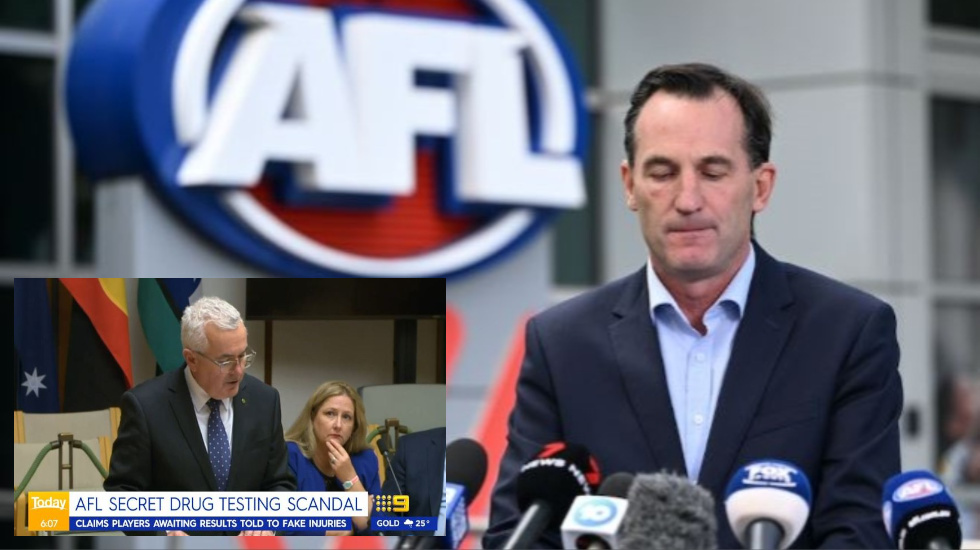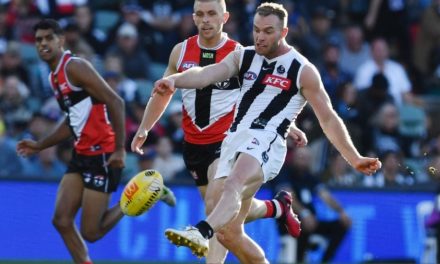For all the hand-wringing, the main objective of the AFL’s illicit drugs testing program must be about welfare rather than punishment.
Football and media are two institutions which don’t do nuance particularly well. Terribly, in fact, when you think about some of the molehills turned into mountains these days.
Which is why when independent MP Andrew Wilkie dropped his bombshell about AFL drug testing in Canberra on Tuesday night, the fall-out was always going to be considerable.
Not so much because of the ramifications for a testing program for illicit drug use which sits uncomfortably alongside drug testing conducted by Sports Integrity Australia (on behalf of WADA) for performance-enhancing substances.
But because of one fundamental and inescapable conclusion. That even in genuinely trying to address the considerable matter of societal drug use among young men under its watch, the AFL had effectively condoned pulling a swifty on the football public.
Which is what happens when “off the books” drug testing on a player records a positive result, the AFL having to choose the lesser of two evils.
Does it allow a player with drugs in his system to run the risk of testing positive on game day, and as Melbourne’s Joel Smith has found, face career-ruining lengthy suspension? Or does it ensure the player doesn’t run that risk by withdrawing him for an upcoming game, and in order to protect doctor-patient confidentiality, concoct an explanation as to his absence?
The AFL’s statement released after Wilkie aired his claims to parliament, made it clear its priority is the latter.
“It is absolutely imperative that no doctor or club official should ever allow or encourage a player to take the field knowing they have recently taken an illicit substance that may be harmful to their health and/or may be deemed performance-enhancing (as many illicit substances are on match day),” it said.
“We are unapologetic about club and AFL doctors taking the correct steps to ensure that any player who they believe has an illicit substance in their system does not take part in any AFL match and that doctor-patient confidentiality is upheld and respected.”
You can argue that the AFL created an unnecessary rod for its own back by instituting the illicit drugs policy in the first place. But having done so, the main objective of that program logically must be about welfare and health and safety rather than existing as a punitive measure.
And that, obviously, doesn’t tally with a player being outed as to the real reason behind his absence from a game against his will.
During his media conference on Wednesday, AFL chief executive Andrew Dillon repeatedly alluded to the age of the illicit drugs policy, first implemented in 2005. The implication clearly was that it had become something of an anachronism.
The thinking behind that belief is interesting, given that what were illicit drugs 19 years ago remain so now. I suspect it’s as much to do with societal changes as any specific part of the policy itself.
PLEASE HELP US CONTINUE TO THRIVE BY BECOMING AN OFFICIAL FOOTYOLOGY PATRON. JUST CLICK THIS LINK.
Those of us with children who are now young adults might be a little more familiar with the concept, but there’s plenty of evidence, anecdotal and otherwise, that rightly or wrongly, taking recreational drugs for younger generations is seen as no big deal, considered not all that different to alcohol, regardless of their legality or otherwise.
As for cocaine, well there’s plenty of people now occupying positions of authority in the corporate world, and no doubt in upper echelons of football clubs as well, who’ve themselves on occasion dabbled in illicit substances.
At least the testing program, as flawed as it is, has a chance of keeping potential wayward sons on the straight and narrow. And with the benefit of hindsight, perhaps if the AFL had sold the concept as such a couple of decades ago, the rest of the football world might have also got on board.
That ship has sailed, however. Because if the AFL didn’t have the confidence to explain its worthy intent properly to the football public then, it sure wouldn’t risk it now.
Not with the continued downward trajectory of mainstream media increasingly framing even the most complex of issues in the most simplistic terms possible, and with increasing calculation to appeal not to a sense of perspective, but to outrage.
The AFL is an easy target at the best of times, and obviously even more so when it is caught red-handed having effectively pulled the wool over the eyes of its audience.
But its intent here has been good. And to the shock jocks and even, sadly, some club officials looking to grandstand about having a right to know very private and sensitive medical information, what is your alternative?
If a drug dependency, as if often the case, goes hand in hand with a player’s mental health issues, what on earth makes a blowhard in front of a radio mic or TV camera or a club president suffering relevance deprivation syndrome so confident their blowing of that player’s cover doesn’t put their lives at risk?
Having waded into this difficult space all those years ago, the AFL now can’t be seen to just wash its hands of the whole business, which would certainly be the easy way out.
And if it really is welfare which is the No.1 priority and not just image, it will also need to stand up to those who see the issue of drugs only ever as a case of right and wrong and testing as a vehicle for punitive action.
To that end, a bit of perspective from everyone else with an agenda to push would help a lot, too. Yeah, I know. I’m not counting on that, either. But we can always hope.
This article first appeared at ESPN.











